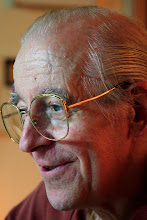The catastrophe at the Fukushima Daiichi Nuclear Power Plant (福島第一原子力発電所, Fukushima Dai-Ichi Genshiryoku Hatsudensh) in Japan is a scientific irony: the world watches as green energy is being turned into an atomic weapon. This situation is like the two faces of Janus, the Roman god of beginnings and transitions. It is tragic that the only country in the world to have been bombed with nuclear weapons is now being exposed to radiation. The Japanese people’s sorrow and distrust cannot be measured. When and how the magma of rage will explode?
 Fukushima Daiichi Nuclear Power Plant (March 14, 2011)
Fukushima Daiichi Nuclear Power Plant (March 14, 2011) Yasuhiro Nakasone (中曽根 康弘, 1918- ), former prime minister of Japan, is probably feeling the most devastated. He is the architect of Japan’s nuclear energy policy. Only seven years into his political career in 1954, Nakasone led the initiative to approve the budget for the peaceful use of nuclear energy. At the time, the Japanese people were still suffering from the cruel aftermath of the atomic bombings in Hiroshima (広島市, Hiroshima-shi) and Nagasaki (長崎市, Nagasaki-shi). Anti-nuclear and anti-American sentiment had reached a peak and many called it a “devil’s budget.”
Amidst such obstacles, Nakasone laid a foundation for nuclear energy development. He sponsored eight bills on nuclear energy. His actions prompted the government to open an agency for atomic energy policy and establish the Japan Atomic Energy Research Institute (日本原子力研究所) and Japan Atomic Energy Commission (原子力委員会, Genshiryokuiinkai). Nakasone’s belief in nuclear energy began when he became aware of the might of nuclear power after the United States’ atomic bombings of the country. He realized that without science and technology, Japan would remain an inferior agricultural country. He did not miss US President Dwight D. Eisenhower (1890-1969) Atoms for Peace speech in 1953. Matsutaro Shoriki (正力 松太郎, 1885-1969), then the Yomiuri Shimbun (読売新聞) owner, supported Japan’s policy to develop atomic energy. Through the media, a massive campaign to promote the policy took place. The popular comic Astro Boy (in Japanese Atom, アトム, Atomu) also appeared at this time.
Even after he retired from politics, Nakasone continued to support the issue. In 2006, he gave a lecture on the 50th anniversary of Ibaraki Prefecture (茨城県, Ibaraki-ken) atomic energy industry. “The most important thing we can do to prevent an accident is do constant inspections. We must be fully prepared for an earthquake or terrorist attack. The nuclear reactors are now about 30 years old. Will they be safe if we are hit with a 6- or 7-magnitude earthquake? It is urgent that we reinforce the facilities to prepare for such emergencies.” The Fukushima Daiichi Nuclear Power Plant is now 40 years old. The solon who had made Japan the world’s top nuclear power after the Untied States and France must feel heartbroken at the current situation there.
The current nuclear crisis will likely create strong repercussions. In 2008, Japan supplied 26 percent of its power through nuclear energy. That amount was to be increased to 49 percent by 2030. The plan, however, will inevitably be reconsidered. And it will not be easy to overcome public resistance against a plan to build 14 new reactors. Two years ago, the cabinet conducted an opinion poll and 42 percent of respondents said they felt confident about safety, while 54 percent said they felt insecure. Japan remembers the nuclear bombings and terrifying aftermath. Memories of that horrible time have been handed down through the generations.
The catastrophe in Fukushima has put a serious damper on the global nuclear energy renaissance. New construction projects have been postponed and existing plants have suspended operation all around the world. There are growing concerns also here in Korea. As of now, Korea supplies 31.4 percent of the country’s power with 21 reactors. That amount was to be increased to 48.5 percent with 35 reactors by 2024.
But is it impossible to turn back time? The 19th century was the era of coal and the 20th century was the era of petroleum. Global warming is the product of both. If the use of nuclear energy is suspended in favour of fossil fuels, it will be as taking a step backward. Coal and petroleum will run out quickly and is Korea ready for skyrocketing oil prices? How will Korea reduce carbon emissions? Commercialization of wind and solar power generation is far away. Korea lacks natural resources, so it will be hard to find an alternative to nuclear energy. Electricity from nuclear power is the pillar of Korea’s industrialization.
However, and this is not a problem restricted to Korea, rather a world problem, the key is safety. Korean nuclear plants must be safe from earthquakes and tsunami. Koreans need to develop advanced reactors with emergency systems that pump cooling agents onto the nuclear fuel rods and must remember that science is a frontier with no limits.
Giorgio Olivotto
Seoul, Korea
March 27, 2011
Seoul, Korea
March 27, 2011

Nessun commento:
Posta un commento